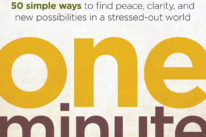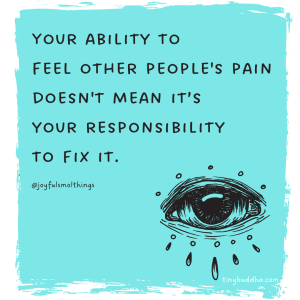
“I vow to let go of all worries and anxiety in order to be light and free.” ~Thich Nhat Hanh
Our daughter is seeing a counselor to help her deal with anxiety. She’s only ten. Cue mother guilt.
There are a whole lot of (mostly crazy) worries running around her little head, some that even I can’t wrap my head around. So I wrap my arms around her and reassure her that things will be okay.
I give her permission to be anxious, but try to instill resilience so she won’t worry so much. I try to teach her mindfulness and meditation and positive thinking. And I worry, about her and too many things—some role model I am!
Mostly, my daughter worries about something happening to her dad or me.
Separation anxiety is the crux of her problem. She’d been avoiding sleepovers with friends and even her grandparents, and it all came to a head when her school camp loomed large.
The good news is she got through camp, thanks to her resilience, mindfulness, her first counseling session, and our pep talks—and despite my worry, which was wasted, as it always is!
Getting through camp was a big achievement for our daughter in her journey to overcoming anxiety, but she has a road ahead as she deals with her fears about losing us, embedded as they are in processing her feelings about being adopted and the loss of her birthparents in her life.
She has a lot to deal with, yet she is brave, strong, resilient.
She’s only ten, but she’s already demonstrating ways to take worry out of her life. I’m beyond proud.
I gained my own painful insights into the futility of worry through a long journey of infertility and an equally long wait for adoption. Loss of control was the only certainty. Yet, I’ve gained the most clarity through my children’s eyes.
Children teach us lessons every day, if we are open to learning them. And they open our closed minds to lessons we learned as kids but have forgotten.
There was a time when worry didn’t exist, as hard as it is for us adults to imagine. It was all about the present; the future wasn’t to be feared.
The key to taking worry out of life, I think, is to reconnect with that sense of child-like wonder, while bringing to each moment the adult wisdom of knowing that worry will never change what happens. That “this too shall pass.”
Here are five ways to overcome worry that I’ve learned and assimilated from what my daughter has so courageously demonstrated.
1. Accept that some worry is good for you.
This sounds counterintuitive, but if you stop worrying about worrying, it’s a really great place to start!
For starters, you need to have some fear in your life for when you are being chased by a lion and need adrenaline to kick in in order to flee (great idea), or when you are confronted and the only choice is to fight.
A bit of worry is normal—good news for anxious people who worry even more about being abnormal. Some stress about consequences keeps us motivated. It keeps us alert to possibilities and shows that we care.
A little bit of worry is natural, normal, and human. Use it wisely.
2. Move through worry.
Can you imagine dancing and being worried at the same time?
Of course, even a prima donna ballerina will have at least a hint of stage nerves (for adrenaline, and because she cares). But the dancers we admire so much, who hold us in thrall, they go to a place where worry cannot exist.
It’s a magical place where their bodies meld with the music and become one, and there’s no time, only rhythm and movement and wonder that we humans are even capable of such beauty.
I’ve watched my ten-year-old dance like this, and I watch her all the time, flipping, cartwheeling, hand standing and doing walkovers, pirouettes etcetera, over and over. She quite literally moves through her anxiety.
She’s not worried at all about dance (other than a few stage nerves), and she loses all other anxious thoughts when she’s lost in the beauty of it.
Movement—be it dance, yoga, running, walking, swimming, or whatever sport or exercise—provides the opportunity to distract yourself from worry, to be lost in the wonder of being able to move your body for its own sake. Little by little, anxiety fades.
3. Sit with worry.
When we stop physical activity, we make room for more thoughts, and that can be scary.
This is when we need mindfulness to simply witness those thoughts—not to judge them, not to feed them so they multiply, but to simply observe them as waves rolling in and out.
If you can separate yourself from your worries and focus on your breath, then you can breathe in fresh air and calm and exhale worry. You create both a physical and mental means of release.
You can open the space for stillness, a place where peace replaces worry.
4. Talk back to worry.
Anxious thoughts are as persistent as they usually are irrational. When they take over our self-talk, it can feel like we can’t change the script. But they’re just lines in a script we run through our heads—a fiction.
Children, with their abundance of imagination, find it harder to separate fact from fiction, and one of the skills my daughter is learning is to think rationally about her anxieties.
For example, I tell her that it’s no more likely something bad will happen to her father and me when she isn’t with us than when she’s tucked up in bed in the next room. She sees the logic.
She worries about us being older parents and not being around for her, and while I can’t change the facts, I can point out that if she does the math her fears of our imminent deaths are unfounded if you look rationally at the figures (we are not that old).
Anxiety cowers in the face of rationality. Arguing back with forceful reason is a way to change your self-talk over time, literally starving your worries of oxygen.
5. Cultivate resilience.
Resilience, along with empathy, is the key quality we are trying to instill in our children. If they never have to cope with failure or disappointment, today’s mollycoddled generation risks falling apart in the face of a crisis.
Resilience is your armor against anxiety. When you cultivate resilience, you have a ready reminder of what you’ve already survived (and often thrived through) in the past. You are shielded by the strength you’ve built up and safe in the knowledge that you can prevail, that things will get better.
Resilience is so much more powerful than blind faith that things will be okay, because with resilience you will be okay regardless.
Worry can’t triumph against such resolve.
—
I wish I could say that getting over anxiety is easy because even a child can do it, but it’s not. It’s hard for our daughter, but we want to try stop anxiety becoming a painful pattern she takes into adulthood.
For us adults, I think we can only work with and through worry—put it in its place, put ourselves in control. Take the lead in this universal dance through life.
About Kathy Kruger
Kathy Kruger is an adoptive mother of two beautiful kids from China. She blogs about going with the flow, finding yin yang balance, embracing change, and being grateful at www.yinyangmother.com. A former journalist, Kathy shares insights from her long journey to motherhood.













 Though I run this site, it is not mine. It's ours. It's not about me. It's about us. Your stories and your wisdom are just as meaningful as mine.
Though I run this site, it is not mine. It's ours. It's not about me. It's about us. Your stories and your wisdom are just as meaningful as mine. 